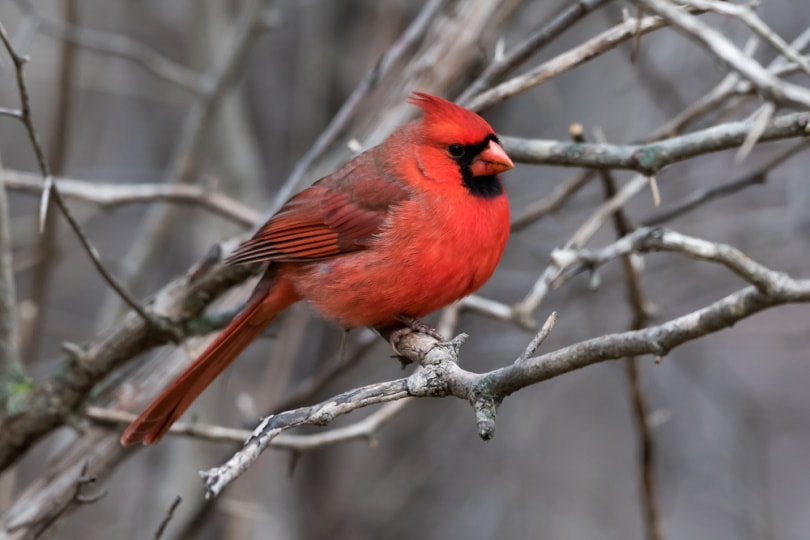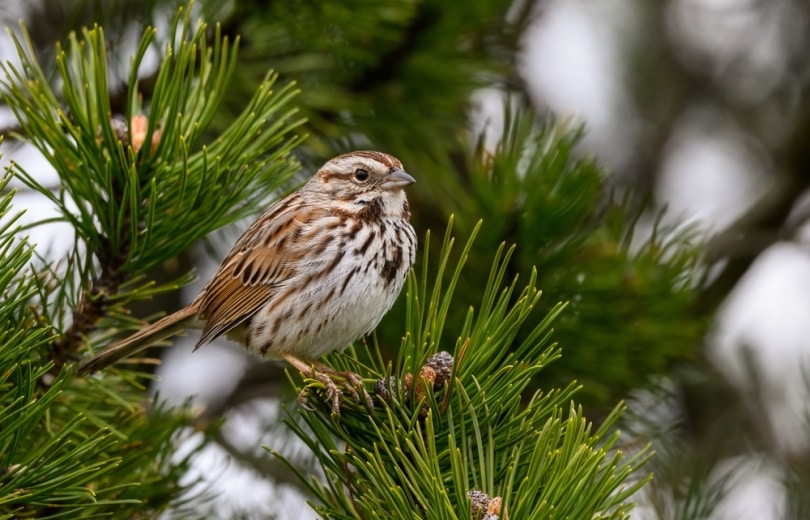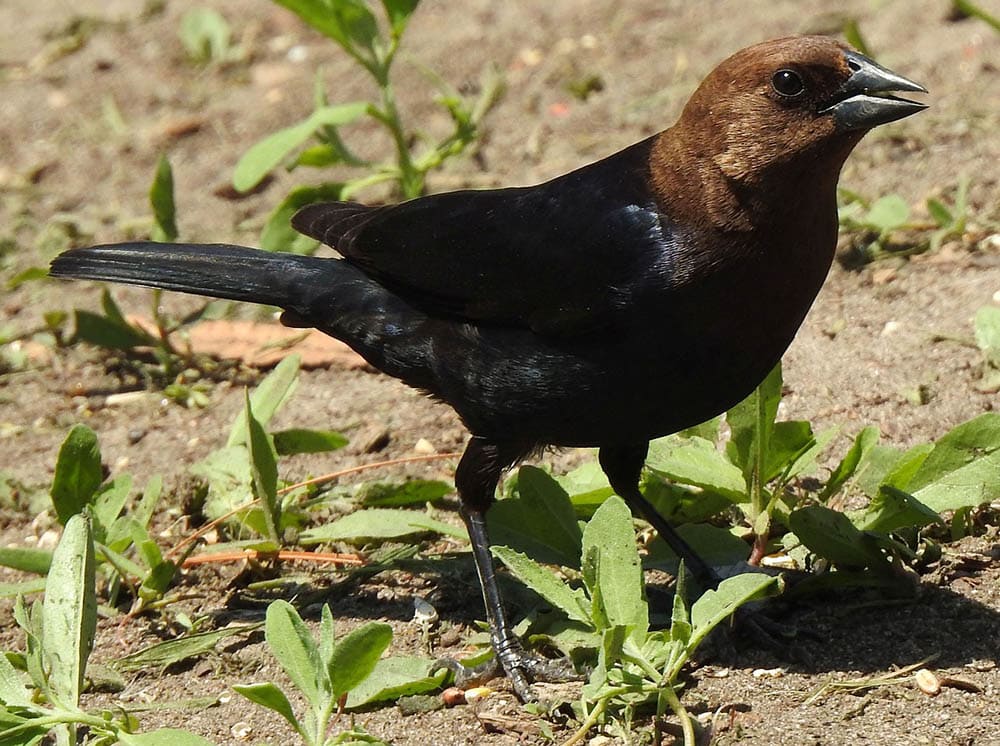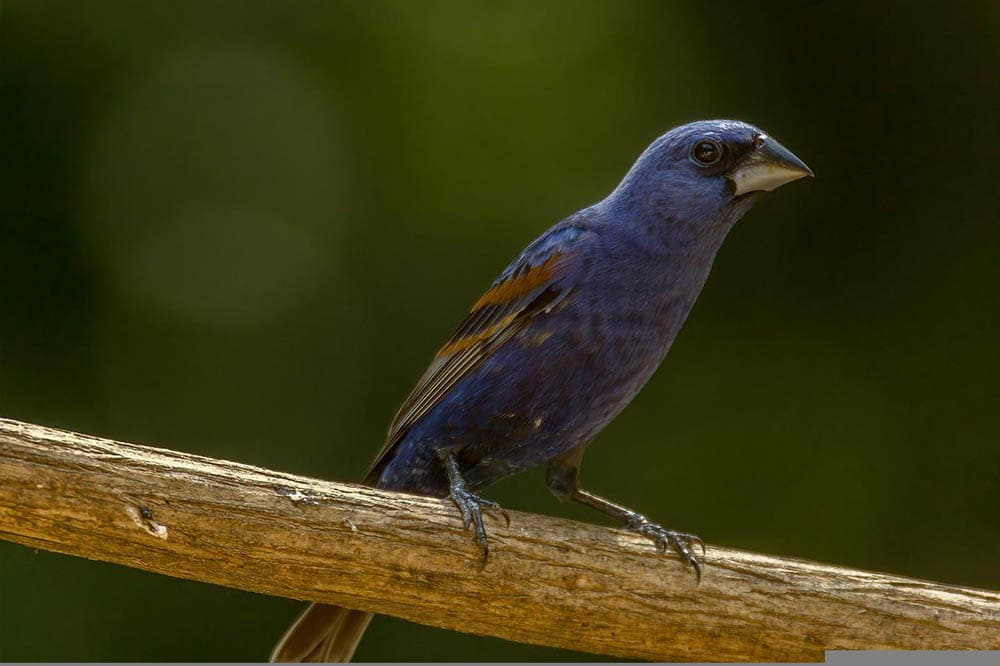32 Common Backyard Birds in Michigan (With Pictures)
Last Updated on

Michigan’s size and close proximity to the Great Lakes, it is no wonder why there are over 450 bird species found in the state. However, that doesn’t mean that you’re going to see all 450 birds in your backyard. There are a small handful of birds that you’ll see on an everyday basis, and there are others that you will have to keep your eyes peeled for.
This article lists 32 of the most common bird species that you are likely to see in a Michigan backyard. Whether you reside here permanently or are just visiting for some summer fun on one of the over 62,700 inland lakes¹, you’ll finish this article knowing a little bit more about the aerial critters that live here.

The 32 Common Backyard Birds in Michigan (with Pictures)
1. American Robin

| Scientific Name | Turdus migratorius |
| Size | 9–11 inches |
| Habitat | Open woodlands |
| Conservation | Low concern |
Starting with Michigan’s very own state bird, the American Robin is arguably one of the most common birds in the US. It’s so popular that even Wisconsin and Connecticut have named it their state bird as well. Some of them travel south for the winter, but many reside in the northern parts of North America throughout the year as well.
You’ll often see American Robins tugging at earthworms in the ground during the early morning hours. They are known for their orange breasts and cheery songs. On average, they are 10 inches long from tail to bill tip. The males are the ones with the rusty orange breast, while the females and younger birds usually have gray-brown coloring.
2. Black-Capped Chickadee

| Scientific Name | Poecile atricapillus |
| Size | 4–6 inches |
| Habitat | Forests |
| Conservation | Low concern |
Many birdwatchers can’t get over the cute appearance of the Black-Capped Chickadee. These small birds have oversized, rounded heads with little bodies. They are curious by nature and don’t often shy away from humans. They have a habit of investigating their entire territory and will likely be one of the first birds to show up at your feeders.
Black-Capped Chickadees have a white bib and a black cap. Their wings, tail, and back are gray with their undersides being more white. Their calls are complex, and they use them to identify other flocks and alert other birds of nearby danger.
3. Blue Jay

| Scientific Name | Cyanocitta cristata |
| Size | 8.5–12.0 inches |
| Habitat | Forests |
| Conservation | Low concern |
As one of the most identifiable birds on the list, the Blue Jay is another common backyard bird in Michigan that you won’t have too much trouble spotting. These are large songbirds that are known for their perky crests and blue, white, and black plumage. They are very intelligent, so much so that they might steal food from other birds at the feeders.
Blue Jays migrate in flocks in the thousands along the coasts of the Great Lakes and the Atlantic Ocean. However, not all of them migrate for the winter. Younger birds are more likely to migrate than adults, but much of their migratory behaviors remain a mystery.
4. Northern Cardinal

| Scientific Name | Cardinalis cardinalis |
| Size | 8.0–9.5 inches |
| Habitat | Open woodlands |
| Conservation | Low concern |
While males are usually the only North American songbirds that sing, this is one of the few species where the females sing as well. The Northern Cardinal is known for its pretty sound and bright red plumage. While the males sing to attract females, the females sing while sitting on their nests to communicate information to the males, like to bring food.
Northern Cardinals are more popular in the eastern half of the US. The males are a stunning shade of red, but even the females are beautiful with their brown feathers with red accents on their crests. Since cardinals don’t migrate, you can find these birds in Michigan all year long.
5. American Goldfinch

| Scientific Name | Spinus tristis |
| Size | 4–5 inches |
| Habitat | Open woodlands |
| Conservation | Low concern |
Another common and beautiful bird in Michigan is the American Goldfinch. These birds are bright yellow and very small–under 5 inches long. The males sport the lemon yellow color with a black forehead and wings, while the females are a dull olive color with a brown tail and wings. They are somewhat plump with large heads and short tails.
If you want to attract an American Goldfinch to your yard, be sure to plant some native thistles or other native plants, like milkweed, around your property. They will likely come to any bird feeder you have, but they especially love to eat the spilled seeds from the ground below.
6. Mourning Dove

| Scientific Name | Zenaida macroura |
| Size | 9–14 inches |
| Habitat | Open woodlands |
| Conservation | Low concern |
The Mourning Dove is one of the most widespread birds in North America. Even though hunters harvest more than 20 million of these birds every year, they remain one of the most abundant and have an estimated US population of 350 million.
Mourning Doves eat roughly 12%–20% of their body weight per day. They have rounded bodies with slender tails and small heads. You can often see them perched on telephone wires or foraging for seeds on the ground. Their drawn-out, soft coos can be heard throughout the day. If you enjoy having these birds around, spread seeds and millet on the ground or put them in your platform feeders.
7. Red-Winged Blackbird

| Scientific Name | Agelaius phoeniceus |
| Size | 9 inches |
| Habitat | Marshes |
| Conservation | Low concern |
Once you’ve identified one of these birds, you’ll start seeing them every time you take a drive. Red-Winged Blackbirds are another abundant bird in North America. They are easy to spot thanks to their bold, bright red patches on the back of their glossy black wings. However, the females are more subdued with a streaky brown color.
You’ll notice that these birds are fierce when it comes to defending their territories during the breeding season. They will chase and sometimes attack other nests from predators. Thankfully, it’s not for nothing. The males can mate up to 15 times in some cases to ensure that their DNA lives on. If you’re dying to see a Red-Winged Blackbird but one hasn’t come to your yard, head out to wetlands and marshes to improve your chances.
8. American Crow

| Scientific Name | Corvus brachyrhynchos |
| Size | 16–21 inches |
| Habitat | Open woodlands |
| Conservation | Low concern |
As one of the larger birds on this list, the American Crow is hard to miss. These are highly intelligent animals that are completely black in color. You can see them in fields, treetops, or on the side of the road. They often forage on the ground, although they’ll eat almost anything from worms, to seeds to small animals. Some have even been known to steal chicks from other birds’ nests.
American Crows get a bad rap, but they are so smart that some people report that they have brought “gifts” to them in exchange for food. They can sometimes even make and use tools, like breaking off pieces of pinecones to drop on other animals that get near their nests. Don’t believe us? Attract some to your yard with peanuts and observe one putting its brain to work.
9. Downy Woodpecker

| Scientific Name | Dryobates pubescens |
| Size | 5.7–6.7 inches |
| Habitat | Forests |
| Conservation | Low concern |
Some people think that woodpeckers can be pests due to drilling into their homes, and while many people would agree, it doesn’t change the fact that these are interesting and beautiful birds to observe. Downy Woodpeckers are a common sight at backyard feeders. They thrive in forests but don’t shy away from parks and other open spaces. Of all the woodpecker species, this one is most likely to visit your backyard.
Woodpeckers don’t sing, but you will know one is around if you hear them drumming against a piece of wood or metal. Be careful, though, because some have been found building nests inside the walls of homes and other buildings.
10. White-Breasted Nuthatch

| Scientific Name | Sitta carolinensis |
| Size | 6 inches |
| Habitat | Forests |
| Conservation | Low concern |
The White-Breasted Nuthatch is an active and agile bird. They have black, gray, and white markings and a hefty appetite for meaty seeds and insects. They spend their time throwing large nuts against trees and hitting them with their bills to break them open.
Even though these birds are small, they have very loud calls. If you know one is nearby, take frequent trips to your feeders to ensure they aren’t stealing and hiding all the food you put out.
11. Song Sparrow

| Scientific Name | Melospiza melodia |
| Size | 4.7–6.7 inches |
| Habitat | Open woodlands |
| Conservation | Low concern |
Song Sparrows are found throughout all of North America, although Michigan is one state where they reside year-round. These birds have brown and gray streaks on their bodies with a white chest. If you see a streaky brown bird flying from shrub to shrub, you can almost guarantee it’s a Song Sparrow.
Even though they are found throughout the continent, they can look different from one another, depending on where they live. For example, Southwest Song Sparrows are pale, and Pacific Northwest Song Sparrows are dark with heavy streaks.
12. Red-Bellied Woodpecker

| Scientific Name | Melanerpes carolinus |
| Size | 9–11 inches |
| Habitat | Forests |
| Conservation | Low concern |
The name of this bird is a little contradictory. You would assume that these birds have a red color on their bellies, but it is actually the head that is covered in red. However, their underparts are white, and they have heavy black-and-white patterning on their wings and tail.
You are more likely to attract Red-Bellied Woodpeckers if you live near forests or wooded patches. They love to eat suet in the winter and peanuts and sunflower seeds throughout the year. Some might also try to take a few sips from your hummingbird feeders.
13. Tufted Titmouse

| Scientific Name | Baeolophus bicolor |
| Size | 6–7 inches |
| Habitat | Forests |
| Conservation | Low concern |
These little gray birds are year-round residents of Michigan’s Lower Peninsula, but you won’t find them in the Upper Peninsula. Mostly found in forests, Tufted Titmouse are regulars at most backyard feeders throughout the year. They have a strong preference for sunflower seeds but will eat many other seeds that you put out.
Your best chance at attracting a Tufted Titmouse is to create a safe place for them to nest. These birds prefer to build their nests high up in tree cavities, so installing a few nest boxes is a sure way to bring them closer. However, you might have to use a guard to keep predators from stealing their eggs.
14. European Starling

| Scientific Name | Sturnus vulgaris |
| Size | 8.5 inches |
| Habitat | Towns |
| Conservation | Low concern |
The European starling was first introduced to the US in the 19th century. Now, they are some of the continent’s most numerous songbirds. Some people resent them for their aggressiveness, but you can’t deny that they are captivating to look at.
European Starlings have stocky bodies with triangular wings and short tails. They are covered in white spots during winter but then turn a dark, glossy, iridescent color in the summer. You’ll most likely see them in large flocks mimicking calls of up to 20 different bird species.
15. House Sparrow

| Scientific Name | Passer domesticus |
| Size | 9.5–7 inches |
| Habitat | Towns |
| Conservation | Low concern |
As you probably guessed by the name, House Sparrows can be found anywhere there are houses or buildings. These birds are extremely common. They are seen in parts of Canada all the way down to the tip of South America. They have a constant presence in Michigan backyards and look similar to the Song Sparrow.
Some people don’t view House Sparrows as desirable house guests since they aren’t native. However, these birds are so closely entwined with human lives that they will likely visit your home even if you don’t feed them. However, if you’re a House Sparrow lover, you can attract them with millet, corn, and sunflower seeds.
16. Common Grackle

| Scientific Name | Quiscalus quiscula |
| Size | 11–13 inches |
| Habitat | Open woodlands, marshes |
| Conservation | Steep decline |
The Common Grackle is a bird you’ll likely find around open wetlands and marshes, although they will visit backyard feeders from time to time. They eat a lot of crops, like corn, but will eat just about anything they can find. Some even pick through the garbage to find a meal.
Common Grackles look like any other blackbird but with long bodies. They are also taller with longer tails than other blackbirds. However, their plumage has a bit of an iridescent color to it with a metallic blue head. Their populations are declining steeply, mainly due to the fact that they are hunted in large numbers because they are considered pests to crops, specifically corn.
17. Northern Flicker

| Scientific Name | Colaptes auratus |
| Size | 12–14 inches |
| Habitat | Open woodlands |
| Conservation | Low concern |
Northern Flickers are a type of woodpecker with large, brown bodies and black-scalloped feathers. When they take flight, you can usually see a patch of yellow under their wings. They spend a lot of time foraging on the ground for ants and beetles, using their curved beaks to dig for them.
If you want to bring a Northern Flicker to your yard, put up a nesting box before the breeding season to attract a pair. You might also consider putting a birdbath in your yard. They might not feed from your feeders, but they’ll surely take a dip in a warm bath.
18. Dark-Eyed Junco

| Scientific Name | Junco hyemalis |
| Size | 5–6.5 inches |
| Habitat | Forests |
| Conservation | Low concern |
Sometimes called “snowbirds,” the Dark-Eyed Junco often arrives in the backyards of Michigan in winter. They come from nearby mountain forests and are about the same size as a House Finch. These birds have round bodies, short necks, and round heads. Their bills are conical, pink, and pointed.
These birds breed across Alaska, Canada, and parts of the Western US. They spend most of their time feeding and hopping from feeder to feeder to get their fill. These juncos prefer eating mixed seeds from hopper feeders or feeder trays.
19. House Finch

| Scientific Name | Haemorhous mexicanus |
| Size | 5.5 inches |
| Habitat | Towns |
| Conservation | Low concern |
While lots of people often view similar birds, like the European Starling as House Sparrow, as pests, they have been a bit more welcoming to the House Finch. This could be because the males have a cheery red breast and head along with a sweet, twittering song.
Fill your feeders with lots of small, black oil sunflower seeds if you want to see some House Finches up close. They may bring flocks of at least 50 birds, though, so make sure you’re prepared to feed the lot.
20. Hairy Woodpecker

| Scientific Name | Dryobates villosus |
| Size | 5.7–6.7 inches |
| Habitat | Forests |
| Conservation | Low concern |
These woodpeckers look similar to Downy Woodpeckers. The males and females are also relatively similar, although the males have a red patch on their heads with more patterning on their wings.
Hairy Woodpeckers can be found throughout Canada, the US, and Mexico. They spend a lot of time on thick tree trunks, and while they eat lots of seeds, they will sometimes peck into a sugar cane and drink the juice from the plant. If any sapsuckers have been around, they will use the holes from those birds and drink sap from leaking bark as well.
21. Brown-Headed Cowbird

| Scientific Name | Molothrus ater |
| Size | 7.5 inches |
| Habitat | Grasslands |
| Conservation | Low concern |
Just like the name implies, the Brown-Headed Cowbird is a stout blackbird with an easily identifiable brown head. Instead of building nests, females focus on laying eggs and dropping them in the nests of other birds. They abandon their young and then allow the new foster parents to raise them.
Because they live in grasslands, the number of the Brown-Headed Cowbirds has increased due to the clearing of woods. Even though they are native to North America, many people consider them a menace. They destroy eggs of other types of birds, some of which are severely endangered.
22. Tree Swallow

| Scientific Name | Tachycineta bicolor |
| Size | 5.5 inches |
| Habitat | Lakes and ponds |
| Conservation | Low concern |
Because they reside near lakes and ponds, Tree swallows can be found throughout all of North America. These birds are impressive aerialists and have beautiful blue, iridescent back feathers and clean, white chests. They use their flying skills to twist through the air and catch flying insects.
Tree Swallows supplement their heavily insect-based diet with lots of berries. During the breeding season, they might visit your compost piles in search of eggshells for extra nutrition.
23. American Tree Sparrow

| Scientific Name | Spizelloides arborea |
| Size | 4–6 inches |
| Habitat | Open woodlands |
| Conservation | Steep decline |
The American Tree Sparrow is similar to the other sparrows on this list. They have plump bodies, long tails, and brown bodies. However, they are in steep decline. Their numbers had dropped by 53% ¹between 1970–2014. So, be thankful if you have this bird as a backyard visitor because they’ll likely be seen in smaller and smaller numbers.
24. Cedar Waxwing

| Scientific Name | Bombycilla cedrorum |
| Size | 6 inches |
| Habitat | Open woodlands |
| Conservation | Low concern |
You’ll know a Cedar Waxwing if you see one. These beautiful birds are only about 6 inches long but they have some of the most simple yet breathtaking plumage. They have a light brown coloring that starts on the crest and transitions to a darker brown then a gray color as you move down the body—almost like an ombre effect. They have a thick black mask that covers their eyes, and a touch of yellow below the breast and on the tip of their tails. They are so beautiful that most birdwatchers categorize them as must-see birds.
25. Chipping Sparrow

| Scientific Name | Spizella passerina |
| Size | –56 inches |
| Habitat | Open woodlands |
| Conservation | Low concern |
Like many of the other sparrows on the list, the Chipping Sparrow isn’t much different from the rest. The brown coloration and marking are similar to most other sparrows. They don’t differ much in size, either. However, these sparrows do travel south for the winter and do not stay in the northern parts of the continent year-round.
26. Gray Catbird

| Scientific Name | Dumetella carolinensis |
| Size | 8.3–9.4 inches |
| Habitat | Open woodlands |
| Conservation | Low concern |
You’re most likely to find the Gray Catbird in central and easter parts of the US during the breeding season. These birds are attracted to shrubs, so it’s not very hard to entice them to your yard.
If you’ve ever been interested in learning bird calls, this would be the perfect one to start with. Like their name, they have a cat-like sound that you won’t be able to forget and that should be relatively easy for you to mimic.
27. Red-Eyed Vireo

| Scientific Name | Vireo olivaceus |
| Size | 6 inches |
| Habitat | Forests |
| Conservation | Low concern |
As one of the most common songbirds in eastern woodlands, these little birds are found throughout all of Michigan. They are relatively small, about the size of an American Goldfinch, and they have long and slim bodies with short tails.
The red iris makes the Red-Eyed Junco stand out compared to other birds. Some find their songs a bit monotonous, but that shouldn’t stop you from spotting one and enjoying its company.
28. Eastern Kingbird

| Scientific Name | Tyrannus tyrannus |
| Size | 7.5–9.1 inches |
| Habitat | Grasslands |
| Conservation | Low concern |
The Eastern Kingbird looks almost like he’s wearing a tuxedo and is ready for business. However, his behavior says otherwise as he twists and turns through the air to catch flies and other flying insects.
Eastern Kingbirds have dark gray upperparts and a white tip on their tails. They also have big heads and wide shoulders. Because of their size, some of them aren’t afraid to harass crows. In the winter, they spend time in South American forests where they supplement their diet with fruit.
29. Barn Swallow

| Scientific Name | Hirundo rustica |
| Size | 5.7–7.8 inches |
| Habitat | Grasslands |
| Conservation | Low concern |
Barn swallows can be seen soaring through the sky with their cobalt blue plumage that glistens in the sun. These are graceful birds with impressive aerial behavior. Most of the time, they are cruising relatively low, several inches above water or the ground.
Barn Swallows won’t come to suet feeders, but they will likely come to a platform feeder if you fill it with eggshells or oysters. Because they have nests made of mud, providing them with some sort of mud source will also be helpful.
30. Eastern Wood-Pewee

| Scientific Name | Contopus virens |
| Size | 5.5–6 inches |
| Habitat | Forests |
| Conservation | Low concern |
The Eastern Wood-Pewee is an olive-brown bird. They don’t have showy markings or plumage, but what they lack in looks they make up for in sound. You can’t forget their undeniable “pee-a-wee” call. It is very high-pitched and easy to distinguish.
These birds tend to forage higher in trees when there are other flycatchers nearby. Like their plumage, their lichen-covered nests are also inconspicuous as they look just like a knot in a branch.
31. Indigo Bunting

| Scientific Name | Passerina cyanea |
| Size | 4.5–5 inches |
| Habitat | Open woodlands |
| Conservation | Low concern |
The Indigo Bunting is one of the most colorful birds on this list. Their blue coloring is so vibrant that it looks like they belong in a rainforest instead of the Northern US. Regardless, they do travel to South and Central America for the winter.
Attract Indigo Bunting to your yard with feeders filled with thistle and nyjer seeds. Because they also eat insects, they might enjoy some live mealworms as a tasty treat.
32. House Wren

| Scientific Name | Troglodytes aedon |
| Size | 4.3–5.1 inches |
| Habitat | Scrub |
| Conservation | Low concern |
If you’re looking for a bird that covers practically the entire Western Hemisphere, then stop your search. The House Wren is widely distributed across Canada, the US, Mexico, Central America, and Southern America. People find them zipping from shrubs to low tree branches while they snatch up insects. These birds love cover of any kind, so consider piling up your clippings and putting them in a pile to provide a safe place for these wrens to gather.

Conclusion
There is no denying that Michigan is full of biodiversity, and we’ve only listed 32 of the nearly 450 bird species that live here either part or full time. If you ever find yourself in the Great Lakes State, grab your binoculars and start looking for these 32 common backyard birds in Michigan.
See also:
Featured Image Credit: Bonnie Taylor Barry, Shutterstock
Table of Contents
- The 32 Common Backyard Birds in Michigan (with Pictures)
- 1. American Robin
- 2. Black-Capped Chickadee
- 3. Blue Jay
- 4. Northern Cardinal
- 5. American Goldfinch
- 6. Mourning Dove
- 7. Red-Winged Blackbird
- 8. American Crow
- 9. Downy Woodpecker
- 10. White-Breasted Nuthatch
- 11. Song Sparrow
- 12. Red-Bellied Woodpecker
- 13. Tufted Titmouse
- 14. European Starling
- 15. House Sparrow
- 16. Common Grackle
- 17. Northern Flicker
- 18. Dark-Eyed Junco
- 19. House Finch
- 20. Hairy Woodpecker
- 21. Brown-Headed Cowbird
- 22. Tree Swallow
- 23. American Tree Sparrow
- 24. Cedar Waxwing
- 25. Chipping Sparrow
- 26. Gray Catbird
- 27. Red-Eyed Vireo
- 28. Eastern Kingbird
- 29. Barn Swallow
- 30. Eastern Wood-Pewee
- 31. Indigo Bunting
- 32. House Wren
- Conclusion
About the Author Robert Sparks
Robert’s obsession with all things optical started early in life, when his optician father would bring home prototypes for Robert to play with. Nowadays, Robert is dedicated to helping others find the right optics for their needs. His hobbies include astronomy, astrophysics, and model building. Originally from Newark, NJ, he resides in Santa Fe, New Mexico, where the nighttime skies are filled with glittering stars.
Related Articles:
Monocular vs Telescope: Differences Explained (With Pictures)
10 Types of Hummingbirds in Arkansas (With Pictures)
8 Types of Hummingbirds in Nebraska (With Pictures)
5 Types of Hummingbirds in Idaho (With Pictures)
3 Types of Hummingbirds in Mississippi (With Pictures)
8 Types of Hummingbirds in Kansas (With Pictures)
5 Types of Hummingbirds in West Virginia (With Pictures)
5 Types of Hummingbirds in Ohio (With Pictures)
